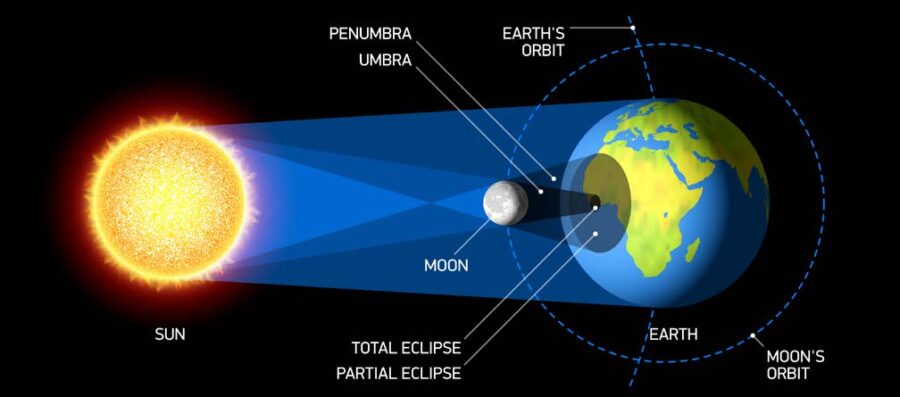What exactly is a Total Eclipse?
A Total Eclipse is an event in which the Moon aligns itself directly between the Sun and the Earth. During this Total Solar Eclipse, the Moon will cast the darkest part of its shadow, the Umbra, onto the Earth as the Moon crosses the Sun’s path and blocks out its light.
The totality of the eclipse is the moment in which the Sun has been entirely covered by the Moon as seen from a place on the Earth. Totality is the peak point of the Eclipse and can last as long as 7mins, 30 secs before the Sun returns to projecting its full unfettered brightness.
Totalities can only be seen in certain parts of the Earth depending on the positioning and time of year of the eclipse, but most places are able to view partial eclipses. The 2017 eclipse will have it’s longest duration of 2 mins, 40 secs at Carbondale, South Illinois. The path of totality will be approx 70 miles wide.

Why do Solar Eclipses occur?
Eclipses occur when the Moon passes between the Sun and Earth. Total Solar Eclipses occur when the Moon passes directly between the two. The Sun is 400 times larger than the Moon, but the Sun is 400 times further away. (Annular eclipses occur when the Moon is slightly closer to the Earth allowing the Sun to peek around its edge).
This difference in size and distance results in the Sun and the Moon having the same angular proportions. Effectively making them “appear” to be the same size in the sky. By holding up your thumb to a full moon you can “eclipse” the moon. Because the Moon is proportionately the same size as the Sun, the Moon can block the Sun during an eclipse.
How often does a Total Solar Eclipse occur?
Solar Eclipses happen on average 2.4 times a year. However, Total Solar Eclipses only happen once every 18 months. This may seem frequent, but this is a global average. If you were to remain in one location in order to view the Total Solar Eclipse, you would only be able to view it once every 375 years.
So, unless you travel the world chasing Total Solar Eclipses this really is a once in a lifetime experience that you don’t want to miss. Put August 21st on your calendar and join your friends, family, and the millions of people who will experience one of the greatest celestial events of our lifetime.
How fast will the Shadow move?
Due to the shape of the Earth (sphere) and the path of totality across it, the Moon’s shadow will travel at different rates as it crosses the surface of our globe. The speed of the Sun, Moon, and the Earth do not change. It is the relative speed of the shadow at the ground that changes.
In general, an eclipse will travel at about 1,100mph at the equator, and as much as 5,000mph near the poles. The 2017 Eclipse will enter Oregon at approximately 3,000mph, slow to a relative speed of about 1,450mph at the center point of the USA, and increase back to about 1,500mph as it dips into the Atlantic in SC.
Why does the Eclipse Shadow move West to East?
We get this question a lot. The Sun rises in the East and sets in the West. Therefore the shadow goes the same direction… Right?
Actually, the Moon orbits the Earth from West to East at approximately 2,100mph. The Earth also rotates from West to East at 1,040mph at the equator. This difference is evident by the fact that the Moon rises later each day.
If the Moon and Earth rotated from East to West at the same rate the Moon would appear stationary in our sky. However, because the Earth’s rotation is less than the Moon, the relative rate of the Moon’s shadow is, therefore, 1,060mph from West to East.